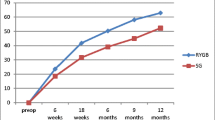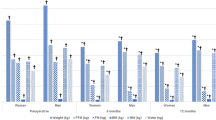Abstract
Purpose
This study aimed to evaluate body composition changes and the determinants of fat-free mass loss (FFML) up to 3 years after sleeve gastrectomy (SG) and one-anastomosis gastric bypass (OAGB).
Materials and Methods
A prospective study was conducted on 3864 patients with severe obesity who underwent either SG (2746, 76.1% women, mean age: 39.2 ± 11.6 years, and BMI: 44.3 ± 5.6 kg/m2) or OAGB (1118, 82.2% women, age: 39.9 ± 10.7 years, BMI: 45.6 ± 6.3 kg/m2). Body composition parameters were measured by bioelectrical impedance analysis preoperatively and 1, 3, 6, 9, 12, 18, 24, and 36 months after surgery. Changes in body composition were assessed using the propensity matched generalized estimated equation (GEE) method. The determinants of fat-free mass loss/weight loss (FFML/WL%) were defined using a mixed-model GEE analysis.
Results
Means of FM, FFM, and FFML/WL% decreased significantly in both study groups (Ptrend < 0.001). Changes in BMI, EWL%, FM, and FFML/WL% were different between the two groups (Pbetween < 0.05). The results showed a better FFM preservation and a greater FM loss over time in the OAGB group compared to the SG group (Pinteraction < 0.05). FFML during the first 3 months was greater in the SG compared to the OAGB group (P < 0.001). SG surgery, higher preoperative BMI, and female gender were associated with greater FFML/WL%.
Conclusion
In the SG compared to the OAGB group, FFML was greater, especially early after the surgery, emphasizing the need for therapeutic interventions such as regular exercise programs and dietary intake modifications.
Graphical abstract




Similar content being viewed by others
References
Auclair A, Piché ME, Biertho L, et al. Changes in fat-free mass and muscle mass at 6 and 12 months after biliopancreatic diversion with duodenal switch surgery. Surg Obes Relat Dis. 2020;16(7):878–85.
Nuijten MAH, Monpellier VM, Eijsvogels TMH, et al. Rate and determinants of excessive fat-free mass loss after bariatric surgery. Obes Surg. 2020;30(8):3119–26.
Marc-Hernández A, Ruiz-Tovar J, Jimenez JM, et al. Short-term changes on body composition and bone mass after one-anastomosis gastric bypass: a prospective observational study. Obes Surg. 2020;30(9):3514–21.
Haghighat N, Kazemi A, Asbaghi O, et al. Long-term effect of bariatric surgery on body composition in patients with morbid obesity: a systematic review and meta-analysis. Clin Nutr. 2020.
Jimenez JM, Ruiz-Tovar J, López M, et al. Assessment of body composition in obese patients undergoing one anastomosis gastric bypass: cross-sectional study. Sci Rep. 2020;10(1):18884.
Guida B, Cataldi M, Busetto L, et al. Predictors of fat-free mass loss 1 year after laparoscopic sleeve gastrectomy. J Endocrinol Invest. 2018;41(11):1307–15.
Sherf-Dagan S, Zelber-Sagi S, Buch A, et al. Prospective longitudinal trends in body composition and clinical outcomes 3 years following sleeve gastrectomy. Obes Surg. 2019;29(12):3833–41.
Zamaninour N, Pazouki A, Kermansaravi M, et al. Changes in body composition and biochemical parameters following laparoscopic one anastomosis gastric bypass: 1-year follow-up. Obes Surg. 2021;31(1):232–8.
Magouliotis DE, Tasiopoulou VS, Svokos AA, et al. One-anastomosis gastric bypass versus sleeve gastrectomy for morbid obesity: a systematic review and meta-analysis. Obes Surg. 2017;27(9):2479–87.
Barzin M, Hosseinpanah F, Motamedi MA, et al. Bariatric surgery for morbid obesity: Tehran Obesity Treatment Study (TOTS) rationale and study design. JMIR Res Protoc. 2016;5(1):e8.
Savastano S, Belfiore A, Di Somma C, et al. Validity of bioelectrical impedance analysis to estimate body composition changes after bariatric surgery in premenopausal morbidly women. Obes Surg. 2010;20(3):332–9.
Widen EM, Strain G, King WC, et al. Validity of bioelectrical impedance analysis for measuring changes in body water and percent fat after bariatric surgery. Obes Surg. 2014;24(6):847–54.
Kim G, Tan CS, Tan KW, et al. Sleeve gastrectomy and Roux-En-Y gastric bypass lead to comparable changes in body composition in a multiethnic Asian population. J Gastrointest Surg. 2019;23(3):445–50.
Otto M, Elrefai M, Krammer J, et al. Sleeve gastrectomy and Roux-en-Y gastric bypass lead to comparable changes in body composition after adjustment for initial body mass index. Obes Surg. 2016;26(3):479–85.
Garciacaballero M, Reyes-Ortiz A, García M, et al. Changes of body composition in patients with BMI 23–50 after tailored one anastomosis gastric bypass (BAGUA): influence of diabetes and metabolic syndrome. Obes Surg. 2014;24(12):2040–7.
Palazuelos-Genis T, Mosti M, Sánchez-Leenheer S, et al. Weight loss and body composition during the first postoperative year of a laparoscopic Roux-en-Y gastric bypass. Obes Surg. 2008;18(1):1–4.
Johnson Stoklossa CA, Forhan M, Padwal RS, et al. Practical considerations for body composition assessment of adults with class II/III obesity using bioelectrical impedance analysis or dual-energy X-ray absorptiometry. Curr Obes Rep. 2016;5(4):389–96.
Tuero C, Valenti V, Rotellar F, et al. Revisiting the Ghrelin changes following bariatric and metabolic surgery. Obes Surg. 2020;30(7):2763–80.
Roushdy A, Abdel-Razik MA, Emile SH, et al. Fasting Ghrelin and postprandial GLP-1 levels in patients with morbid obesity and medical comorbidities after sleeve gastrectomy and one-anastomosis gastric bypass: a randomized clinical trial. Surg Laparosc Endosc Percutan Tech. 2020;31(1):28–35.
Takiguchi S, Murakami K, Yanagimoto Y, et al. Clinical application of ghrelin in the field of surgery. Surg Today. 2015;45(7):801–7.
Golzarand M, Toolabi K, Djafarian K. Changes in body composition, dietary intake, and substrate oxidation in patients underwent laparoscopic Roux-en-Y gastric bypass and laparoscopic sleeve gastrectomy: a comparative prospective study. Obes Surg. 2019;29(2):406–13.
Coen PM, Carnero EA, Goodpaster BH. Exercise and bariatric surgery: an effective therapeutic strategy. Exerc Sport Sci Rev. 2018;46(4):262–70.
Hassannejad A, Khalaj A, Mansournia MA, et al. The effect of aerobic or aerobic-strength exercise on body composition and functional capacity in patients with BMI ≥35 after bariatric surgery: a randomized control trial. Obes Surg. 2017;27(11):2792–801.
Schiavo L, Pilone V, Tramontano S, et al. May bioelectrical impedance analysis method be used in alternative to the dual-energy X-ray absorptiometry in the assessment of fat mass and fat-free mass in patients with obesity? Pros, Cons, and Perspectives. Obes Surg. 2020;30(8):3212–5.
de Oliveira PAP, Montenegro ACP, Bezerra LRA, et al. Body composition, serum sclerostin and physical function after bariatric surgery: performance of dual-energy X-ray absorptiometry and multifrequency bioelectrical impedance analysis. Obes Surg. 2020;30(8):2957–62.
Acknowledgements
The authors would like to thank the hospital staff, study assistants, and coordinators that took part in this research. Also, special thanks for Mohammadreza Golsibi for his assistance and support of the electronic data collection system. This article was derived from the disease registry entitled “Registration of patient in Tehran Obesity Treatment Center” and approved under the ethical code of “IR.SBMU.ENDOCRINE.REC1397.059” (date: 2018-05-08) by the local ethic committee.
Funding
The study was supported by the deputy of research and technology of Shahid Beheshti University of Medical Sciences (http://www.dregistrysbmu.ac.ir).
Author information
Authors and Affiliations
Corresponding author
Ethics declarations
Ethical Approval
This study was approved by the institutional review board (no. IR.SBMU. ENDOCRINE.REC 1397.0592018–05-08). Informed consent was obtained from all the participants included in the study. All procedures were performed in accordance with the ethical standards of the institutional and national research committees and the 1964 Helsinki declaration and its later amendments.
Informed Consent
Informed consent was obtained from the participant included in the study.
Conflict of Interest
The authors declare no competing interests.
Additional information
Publisher's Note
Springer Nature remains neutral with regard to jurisdictional claims in published maps and institutional affiliations.
Rights and permissions
About this article
Cite this article
Barzin, M., Heidari Almasi, M., Mahdavi, M. et al. Body Composition Changes Following Sleeve Gastrectomy Vs. One-Anastomosis Gastric Bypass: Tehran Obesity Treatment Study (TOTS). OBES SURG 31, 5286–5294 (2021). https://doi.org/10.1007/s11695-021-05722-1
Received:
Revised:
Accepted:
Published:
Issue Date:
DOI: https://doi.org/10.1007/s11695-021-05722-1




